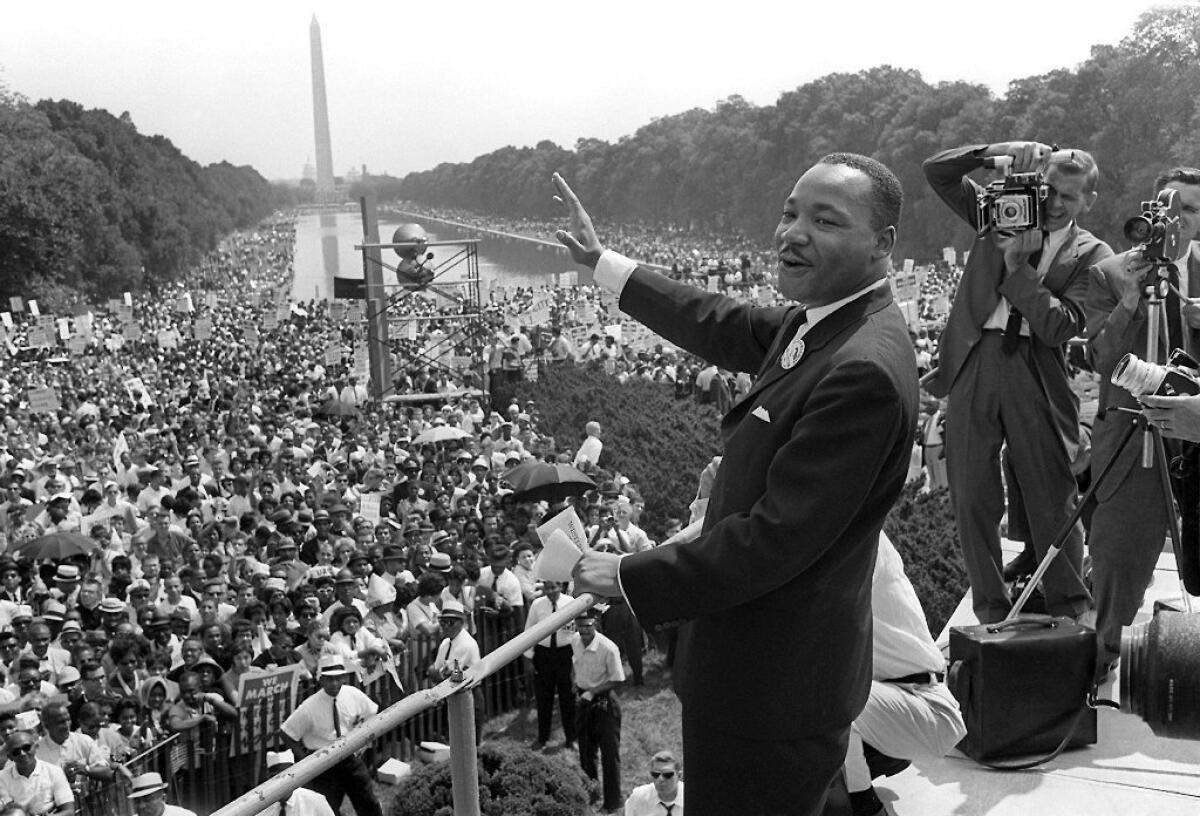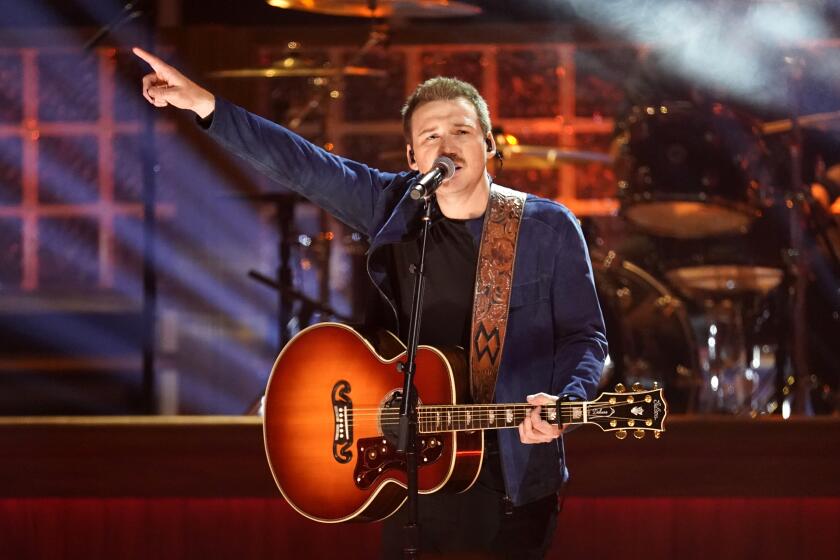Federal humanities grants aim to put scholars on best seller lists

Martin Luther King on the National Mall in Washington, D.C. in 1963. A new grant grant program of the National Endowment for the Humanities aims to give scholarly books a mass audience and a shot at best seller lists. One of the first grants is for a book on the impact of King’s 1968 assassination.
Aiming to show that scholarly research in literature, history and the arts remains lively and relevant in an era dominated by science, engineering and technology, the National Endowment for the Humanities has embarked on a “Public Scholars” campaign to generate books that embody excellent scholarship yet have a solid chance of landing on best-seller lists.
But the head of one national group for humanities scholarship, the Humanities Education and Research Assn., said Tuesday that the way the new program is being presented risks trivializing what scholarship is all about -- and could leave less grant money for important but less accessible kinds of research.
The Public Scholars initiative accounts for 36 of the 212 grants in a $36.6 million funding round the federal agency announced Tuesday. The NEH makes government grants for scholarly research, exhibitions, archives and documentary films.
SIGN UP for the free Essential Arts & Culture newsletter >>
Wendy Lesser, a Berkeley-based author who founded the arts and literature journal Threepenny Review, will get $42,000 to help her write “A Portrait of Light and Shadow,” billed by the NEH as “the first full-length biography of Louis Kahn,” one of the great American architects of the 20th century. She’s the only California author to land a Public Scholars grant.
The aim of the grants, which total $1.7 million and are capped at $50,400 each, is “to enable the publication of…nonfiction books that will bring important humanities scholarship into book clubs and onto best-sellers lists,” and to “make scholarship relevant to contemporary life,” the NEH announcement said.
The new program comes at a time when the humanities – which include literature, the arts, history and philosophy – increasingly are perceived as embattled and overshadowed by science and technology. Those fields commonly are now regarded as more practical, influential and forward-looking -- and as surer pathways for young people hoping for secure, well-paid jobs and older workers who want to change course in midstream.
Other book topics being funded under the Public Scholars program include “an animal’s-eye view of U.S. history since 1400;” archaelogical finds at Meggido, the biblical Armageddon; the impact of Martin Luther King’s assassination; a history of the Tet Offensive during the Vietnam War; an economic history of substance addiction in modern life; the history of hunting in the United States; the Chicago soul music scene of the 1960s and 1970s; Manhattan’s avant-garde downtown arts scenes of the 1960s and 1970s; and studies of Claude Monet, William Faulkner and Louisa May Alcott’s “Little Women.”
While the NEH has a history of funding some research projects that have reached a mass audience, this is the first time it has set aside a separate pot of money for applicants who are interested in writing books for the general public. Previously, projects with potential mass appeal were evaluated alongside research proposals aimed at presenting new finds or theories to a more limited audience of fellow-scholars.
The NEH received no additional funding to launch the Public Scholars program, so the grants are being carved out of the existing budget – potentially at the expense of funding for more arcane but nevertheless important academic books. In recent years the agency’s funding has been flat at $146 million.
“I wouldn’t say it’s repurposing” money that previously went to other types of grants, agency spokeswoman Paula Wasley said Tuesday. “It does not take away from the perhaps more traditional scholarly programs where the emphasis is on research.”
But Edmund Cueva, president of the Humanties Education and Research Assn., said that earmarking money according to a book’s commercial potential “might cause some overall harm to funding for traditional humanities research.”
Cueva, a professor of classics and humanities at the University of Houston-Downtown, said that emphasizing book clubs and best seller lists “sort of waters down what the humanities can offer the public. It would be nice to be on best-seller lists, but we have so much more to offer.”
Cueva said he has no beef with any of the specific projects the NEH is funding under the Public Scholars banner. “Looking at them quickly, these appear to be top-of-the-line research,” he said. “But why they are supposed to appeal to best-seller lists and book clubs, that I don’t understand.”
There were 485 applicants for the 36 Public Scholar grants, endowment spokeswoman Wasley said. Applicants had to submit writing samples to give jurors who ranked the proposals a sense of whether they had a sufficiently accessible prose style. The grants were restricted to scholars who have a track record of published books, articles or essays that had a wide readership.
California scholars and filmmakers in all grant categories landed 17 grants totaling $2.8 million, with eight grants to researchers in Southern California.
The largest California grant, $325,000, goes to USC to evaluate and improve Scalar, an online, open-source platform for scholarly articles that’s housed at the university. Scholars can use Scalar to publish their work and have it examined by their academic peers in ways that, according to the project’s website, “make scholarly publishing…as easy as blogging.”
The L.A.-based International Documentary Assn. will get $60,000 for a 90-minute film by Joseph Angier, “Lives in Vengeance: the True Story of `The Searchers.’”
While a documentary on the critically revered 1956 western by John Ford that starred John Wayne as a fanatical hater of Native Americans clearly has mass-audience potential, it doesn’t fall under the Public Scholars initiative, which is strictly for authors of books.
UCLA’s Fowler Museum will get $75,000 for “Striking Iron: the Art of African Blacksmiths,” an exhibition tracing blacksmithing in sub-Saharan Africa from 500 BC to the present. Museum director Marla Berns said she expects it to open in the spring of 2018 at the Fowler, followed by an international tour.
UCLA also landed $286,337 for archaeology professor John Papadopoulos’ research and excavation work in northern Greece to document how trade and industry informed the origins of the Greek alphabet.
Cal State Long Beach will get $166,000 for educational workshops aimed at helping secondary school teachers develop lessons on how the Cold War impacted Southern California.
The biggest grants in the funding round were $600,000 each for film documentaries on Joseph Stalin and science fiction author Ursula K. Le Guin. Twin Cities Public Television of St. Paul, Minnesota is tackling Stalin, with producer Catherine Allan in charge; Arwen Curry is directing the Le Guin film for the Massachusetts-based Center for Independent Documentary.
New York-based Women Make Movies will get $550,000 for a 90-minute documentary on the television series “Soul!”, which ran from 1968 to 1973 as the first national television show on black culture. Entitled “Mr. Soul! Ellis Haizlip and the Birth of Black Power TV,” it’s overseen by Melissa Haizlip, niece of the TV show’s host and producer.
In its latest grant for an online gaming project, the NEH awarded $400,000 to New York City public television station WNET to develop an educational interactive game, “Mission US: No Turning Back,” that aims to immerse players in what it was like to live under Jim Crow, the 20th century system of racist social and political restrictions aimed at keeping black Americans down.
Grants for art exhibitions include $400,000 to the Philadelphia Museum of Art for a traveling show, “Mexican Modernism, 1910-1950;” $460,000 to the New York Bronx Botanical Garden for “American Impressionists in the American Garden,” a touring exhibition on how gardens were represented by impressionist painters; and $400,000 to create a new permanent exhibition on 19th century landscape painter Thomas Cole at the Thomas Cole Historic House in Catskill, New York.
Follow https://twitter.com/boehmm of the LA Times for arts news and features
SIGN UP FOR OUR ENTERTAINMENT NEWSLETTERS:
Indie Focus: Your field guide to only good movies
Classic Hollywood: A weekly email celebrating the Golden Age of Hollywood
Essential Arts & Culture: A curated look at SoCal’s wonderfully vast and complex arts world
More to Read
The biggest entertainment stories
Get our big stories about Hollywood, film, television, music, arts, culture and more right in your inbox as soon as they publish.
You may occasionally receive promotional content from the Los Angeles Times.







